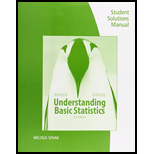
Concept explainers
Estimating the Standard Deviation: Veterinary Science How much should a healthy kitten weigh? A healthy 10-week-old (domestic) kitten should weigh an average of
(a) Estimate the standard deviation of the x distribution. Hint: See Problem 31.
(b) What is the
(c) What is the probability that a healthy 10-week-old kitten will weigh more than 33 ounces?
(d) What is the probability that a healthy 10-week-old kitten will weigh between 14 and 33 ounces?
(e) Inverse
(a)
The standard deviation of x values using rule of thumb.
Answer to Problem 34P
Solution:
The standard deviation of x values using rule of thumb is 5.25.
Explanation of Solution
According to the rule of thumb for estimating the standard deviation from 95% range of data values is:
The standard deviation of x values using rule of thumb is 5.25.
(b)
The probability that a healthy 10 week old kitten will weigh less than 14 ounces.
Answer to Problem 34P
Solution:
The probability that a healthy 10 week old kitten will weigh less than 14 ounces is 0.0228.
Explanation of Solution
We have normal distribution with
By using formula for normal distribution:-
By using Table 3 from appendix
The probability that a healthy 10 week old kitten will weigh less than 14 ounces is 0.0228.
(c)
The probability that a healthy 10 week old kitten will weigh more than 33 ounces.
Answer to Problem 34P
Solution:
The probability that a healthy 10 week old kitten will weigh more than 33 ounces is 0.0526.
Explanation of Solution
We have normal distribution with
By using formula for normal distribution:-
By using Table 3 from appendix
The probability that a healthy 10 week old kitten will weigh more than 33 ounces is 0.0526.
(d)
The probability that a healthy 10 week old kitten will weigh between 14 and 33 ounces.
Answer to Problem 34P
Solution:
The probability that a healthy 10 week old kitten will weigh between 14 and 33 ounces is 0.9246.
Explanation of Solution
We have normal distribution with
By using formula for normal distribution:-
By using Table 3 from appendix
The probability that a healthy 10 week old kitten will weigh between 14 and 33 ounces is 0.9246.
(e)
The cutoff point for the weight of an undernourished kitten.
Answer to Problem 34P
Solution:
The cutoff point for the weight of an undernourished kitten is 17.8 ounces.
Explanation of Solution
We have normal distribution with
A kitten whose weight is in the bottom 10% of the probability distribution of weights is called undernourished.
From above we have
Area left of z = 0.10
By using Table 3 from appendix
By using formula for normal distribution:-
The cutoff point for the weight of an undernourished kitten is 17.8 ounces.
Want to see more full solutions like this?
Chapter 7 Solutions
Student Solutions Manual for Brase/Brase's Understanding Basic Statistics, 7th
- 9. The concentration function of a random variable X is defined as Qx(h) = sup P(x ≤ X ≤x+h), h>0. Show that, if X and Y are independent random variables, then Qx+y (h) min{Qx(h). Qr (h)).arrow_forward10. Prove that, if (t)=1+0(12) as asf->> O is a characteristic function, then p = 1.arrow_forward9. The concentration function of a random variable X is defined as Qx(h) sup P(x ≤x≤x+h), h>0. (b) Is it true that Qx(ah) =aQx (h)?arrow_forward
- 3. Let X1, X2,..., X, be independent, Exp(1)-distributed random variables, and set V₁₁ = max Xk and W₁ = X₁+x+x+ Isk≤narrow_forward7. Consider the function (t)=(1+|t|)e, ER. (a) Prove that is a characteristic function. (b) Prove that the corresponding distribution is absolutely continuous. (c) Prove, departing from itself, that the distribution has finite mean and variance. (d) Prove, without computation, that the mean equals 0. (e) Compute the density.arrow_forward1. Show, by using characteristic, or moment generating functions, that if fx(x) = ½ex, -∞0 < x < ∞, then XY₁ - Y2, where Y₁ and Y2 are independent, exponentially distributed random variables.arrow_forward
- 1. Show, by using characteristic, or moment generating functions, that if 1 fx(x): x) = ½exarrow_forward1990) 02-02 50% mesob berceus +7 What's the probability of getting more than 1 head on 10 flips of a fair coin?arrow_forward9. The concentration function of a random variable X is defined as Qx(h) sup P(x≤x≤x+h), h>0. = x (a) Show that Qx+b(h) = Qx(h).arrow_forward
- Suppose that you buy a lottery ticket, and you have to pick six numbers from 1 through 50 (repetitions allowed). Which combination is more likely to win: 13, 48, 17, 22, 6, 39 or 1, 2, 3, 4, 5, 6? barrow_forward2 Make a histogram from this data set of test scores: 72, 79, 81, 80, 63, 62, 89, 99, 50, 78, 87, 97, 55, 69, 97, 87, 88, 99, 76, 78, 65, 77, 88, 90, and 81. Would a pie chart be appropriate for this data? ganizing Quantitative Data: Charts and Graphs 45arrow_forward10 Meteorologists use computer models to predict when and where a hurricane will hit shore. Suppose they predict that hurricane Stat has a 20 percent chance of hitting the East Coast. a. On what info are the meteorologists basing this prediction? b. Why is this prediction harder to make than your chance of getting a head on your next coin toss? U anoiaarrow_forward
 Glencoe Algebra 1, Student Edition, 9780079039897...AlgebraISBN:9780079039897Author:CarterPublisher:McGraw Hill
Glencoe Algebra 1, Student Edition, 9780079039897...AlgebraISBN:9780079039897Author:CarterPublisher:McGraw Hill
